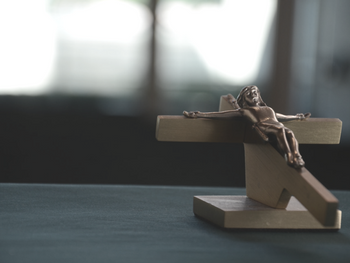
(This article was also pubished here in Spanish. Este artículo también fue publicado aquí en español.)
Congratulations! You and your RCIA team have worked so hard to prepare your catechumens and candidates to get them ready for this life-changing moment. Consider this a virtual hug and pat on the back for all your dedication, effort, and grit. I know you may be thinking the Holy Spirit had more to do with it than you did, which may be true theologically. But the Spirit works through you and with your cooperation. And that’s no small thing. You did a great job!
If you are anything like me (and I pray you’re not!), you’re going to be on pins and needles during the Vigil. You are going to want so badly for everything to be perfect for your seekers. And much of what happens will be out of your control. I hate being out of control.
I have a few suggestions for you. These are actually suggestions for my former self. I can’t say that I ever successfully followed my own advice, but I like to think I got a little better — and a little calmer — each year. So, if you’re anything like me, here are some thoughts about how to better experience the joy and mystery of the Easter Vigil — even if you are not in control.
We know that Sunday Mass is actually two liturgies that make up a whole: liturgy of the word and liturgy of the eucharist. The Easter Vigil is four liturgies: light, word, water, eucharist. To help you better focus on the spirit of this night, try to see the presence of Christ in each of the four liturgies.
Liturgy of Light
- Was the paschal fire lit after complete darkness? What was your sense of Christ as the fire broke apart the darkness?
- Could you see the Easter Candle as it was lit? How did you experience Christ in that moment?
- Was the procession from the fire to the worship space organized or a little chaotic? What did that moment say to you about the People of God?
- The Exsultet is a long and complicated sung proclamation of praise before the Easter Candle. Try to listen for one or two particularly memorable phrases or images. Hold on to that image throughout the night.
- Note if your image or the idea of your phrase from the Exsultet is echoed in any other places in the Vigil.
Liturgy of the Word
The liturgy of the word is more complicated than on Sunday. There are nine possible readings (seven from the Old Testament and two from the New Testament) plus eight responsorial psalms. Only three of the Old Testament readings are required, however, and many parishes choose not to do all seven. I think that’s sad, and if your parish does all seven, find out who to thank! Also, there is a prayer after each reading, similar in form to the prayer after communion.
- To help you more deeply discover the mystery of Christ in these readings, read and pray over them before the Vigil. You can find all the possible options on the USCCB website: http://www.usccb.org/bible/readings/ And you can contact your parish office to find out which readings will actually be proclaimed at your Vigil. In any case, focus your prayer especially on the gospel reading.
- Then, at the Vigil, ask the Holy Spirit to guide your mind to one key phrase or image in each reading. Try to hold on to each of those images throughout the night.
- Listen intently to the prayer after each reading. Listen for an echo of your image.
- As you sing the responsorial psalm, your image may not be echoed. But it is very likely some feeling or emotion your image stirs in you will also be stirred up by the psalm. Pay attention that. That is a gift of the Holy Spirit, revealing Christ more deeply to you on this extraordinary night.
Liturgy of Water
After the homily, the catechumens are called to the baptismal font. In my experience, this moment is a bit of joyful chaos and high expectation. Sometimes the Litany of Saints is sung as the catechumens process to the font and in other places it is sung after they have assembled.
- As you sing the litany, listen for your name or your baptismal name. Listen for the names of relatives or friends who have guided you in your own faith. Listen for the names of the catechumens. If the name of someone important is not included, silently include it as you sing, “All holy men and women, Saints of God….”
- The blessing of water is a long, complicated prayer. As it is sung, listen for echoes of images that you are holding onto from the Exsultet and the readings.
- Also, focus on the physical action. Where is the priest standing? What gestures does he make? How do you recognize Christ in those actions?
- I probably don’t have to give you any suggestions for recognizing Christ in the moment of baptism or in the anointing with Chrism. Perhaps, if you can, remember one wound or burden that each of your catechumens carried when they first began their journey of faith. As you see them washed, as you see them anointed, pray that Jesus heals their wound and forever bears up their burden.
Once the presider begins the prayer over the gifts, everything that follows is fairly “normal,” and I stopped worrying so much about what might go wrong. However, this is the climax of initiation for the newly baptized.
Liturgy of the Eucharist
Whenever I have been in charge of the liturgy for Easter Vigil, I always exhaled when we got to this point. Once the presider begins the prayer over the gifts, everything that follows is fairly “normal,” and I stopped worrying so much about what might go wrong. However, this is the climax of initiation for the newly baptized.
The rubrics provide an option for the presider to briefly address the newly baptized about the great mystery they are about to partake of. Most parishes do not do this, which is a shame. However, you can be inspired by this rubric to deepen the moment of communion with Jesus for both yourself and the newly baptized.
- During the day on Holy Saturday or another time before the Vigil, write a sentence to each catechumen about what you hope for them in this singular moment. If appropriate, connect your hope with the wound or burden that the catechumen had carried. Emphasize the joy and peace that you have experienced from sharing in the Body and Blood of Christ.
- If possible, keep your thought to one, compact, rich sentence.
- As each of the newly baptized shares in communion, read to yourself your hope for him or her.
- Sometime after the Vigil, perhaps when you gather to reflect on the night, share with each neophyte what you had prayed for him or her at the very moment of their communion.
- During the communion of the assembly and as you sing the song during communion, listen for echoes of the images you are holding from the Exsultet and the readings.
- After the final blessing and as you sing the closing song, begin to form an answer to a friend or work colleague who on Monday might ask you, “So what did you do for Easter?”
All of us at TeamRCIA will be praying for you on the holiest of nights. We are so grateful for all the work you have done. Thank you for saying yes to this indispensable vocation.
Your turn
What are some of the lessons you’ve learned from past Easter Vigils? What new steps are you looking forward to incorporating this year? Share your thoughts in the comments below.









We are trying something new this year, based on the experience of our newest priest. We are reading the Genesis reading out by the fire; we will light the fire when “And God said: let there be light”
Then, all the people will come in, except the candle, clergy, & candidates. They will stop at the lintel of the worship space and we will proclaim the Exodus reading. Then, the candle et al will enter. I’m excited to see how this plays out.
In preparation for the Easter Vigil we celebrate the rites for Holy Saturday Morning. Our priest if the principle presider for these rites. These rites can be found in the Book of the RCIA. There are many choices according to needs and status of the Elect. We do the presentation of the Our Father, recitation of the creed, and close with the Ephphatha Rite.
We have been celebrating these rites for five years. Our team has noted that it sets a spiritual sense in the elect, their parents, godparents and the team members themselves.